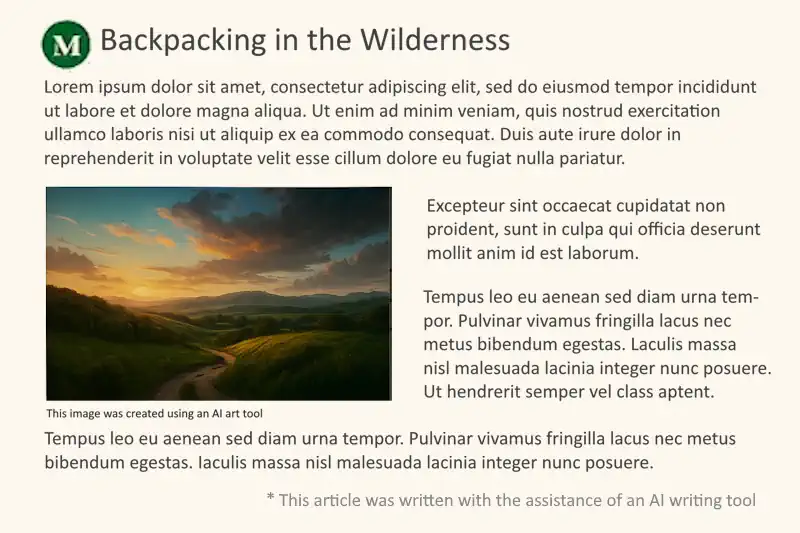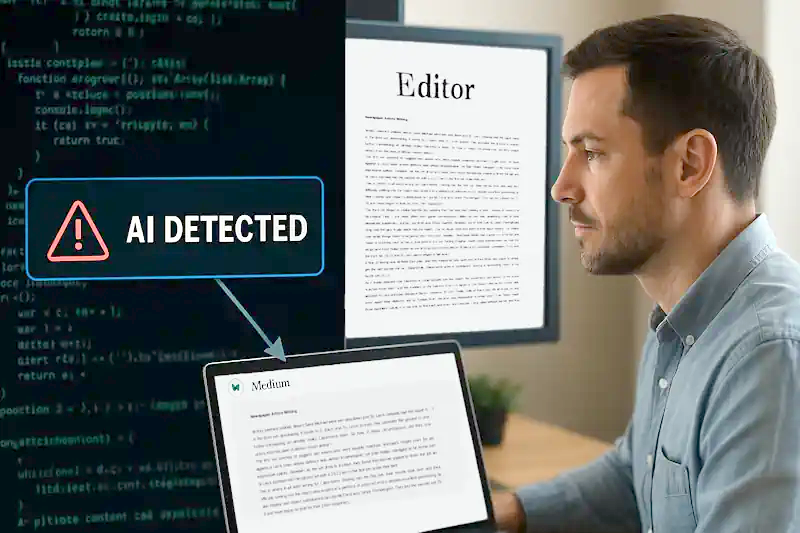AI Tools and Medium’s Guidelines
Using AI to enhance your writing and workflow is not only possible on Medium—it’s expected at this point. Most serious content creators rely on digital tools to streamline brainstorming, improve their language, check accuracy, and even generate visuals.

But Medium draws a clear line between using AI as a writing assistant and turning in a fully AI-generated article. If you cross that line—especially inside their Partner Program—it’s not just a slap on the wrist. It can get your content removed, your distribution limited, or your entire earnings account shut down.
The platform allows AI to support the writing process but not to replace the writer. That’s the guiding principle behind Medium’s AI policy. What they care about is authorship—whether you’re actually the person behind the idea, structure, and expression or just copying and pasting what a bot spit out.
Medium’s Core AI Policy
If the majority of your article is untouched AI output, it doesn’t matter if you disclose it. That kind of content is not eligible for paywall placement under the Partner Program. It can be published, but only as free content, and it won’t be promoted widely. It’s restricted to your personal network—your followers and email subscribers. No curation. No algorithmic push. No Boost.
If you want your content to reach Medium’s broader audience or to earn money through member reading time, then the work has to be yours. You can still use AI tools, but in a way that supports your own thinking.
That means AI can help you plan an outline, generate title ideas, clean up grammar, or fact-check details. You don’t have to disclose that. But if you drop in full paragraphs or large sections of AI-written text—even if you tweak them a bit—you need to say so clearly within the first two paragraphs.
Something like “This article was written with the assistance of an AI writing tool” is enough. If you don’t include a disclosure, Medium may downgrade your distribution and limit your visibility across the site.
AI Image Disclosure Requirements
This disclosure rule also applies to AI-generated images. You’re free to use them in your articles, but you must say they were created with AI. That can be a short caption under the image—something like, “This image was created using an AI art tool.”
If you skip this step, it’s considered a policy violation. And if your AI image breaks Medium’s community standards—say, if it’s offensive, explicit, or misleading—that’s an even bigger issue.
Medium won’t tolerate content that uses AI to create nonconsensual imagery, promote false narratives, or otherwise manipulate users in unethical ways. Where things get tricky is when creators try to game the system.

Common AI Policy Violations to Avoid
Some try to blend AI-written content with their own just enough to pass human detection. Others summarize, rephrase, or remix existing content through AI tools to produce derivative works.
That’s not allowed, either. It falls under plagiarism. Even if the output is technically different on the surface, if the core concept, structure, or language mimics another piece—especially one you didn’t write—it’s still considered theft.
That includes republishing blog posts through an AI spinner, converting YouTube videos to Medium articles, or summarizing someone else’s ideas without significant transformation and personal input.
Medium is also cracking down on AI-written content created purely to rank in search engines. If your story reads like a keyword dump, pushes affiliate links, or resembles a low-effort product review or movie summary, don’t expect it to get far.
These articles are often flagged for low quality or spammy behavior and either removed or stripped of distribution privileges. The platform is leaning hard into trust and originality, especially as the flood of AI content increases. If your work feels like it was made to manipulate rather than serve readers, it’s not going to perform—and it may not even survive moderation.
Approved AI Usage Examples
So how do you stay compliant while still making smart use of AI? Treat it like a co-pilot, not a ghostwriter. You can ask it questions to jumpstart your thinking. You can have it generate a rough draft of an outline.
You can plug in a few bullet points and have it flesh them out, then rewrite them in your voice. You can use it to experiment with tone or to test how a paragraph sounds in different variations. But your hand has to stay on the wheel. The final structure, point of view, and editing choices need to come from you.
AI Image Best Practices
For image generation, follow the same logic. Use AI art tools to create visual content that enhances your message, but don’t use them to deceive. If you’re showing a conceptual graphic, futuristic mock-up, or a stylized portrait, that’s fine—just disclose it.
But don’t upload a hyper-realistic photo of a person who doesn’t exist and present them as real. That crosses into manipulation and breaks Medium’s policies on truthfulness and user safety.
AI Tools That Don’t Require Disclosure
Medium doesn’t currently require you to disclose when you use AI tools for spelling, grammar, or fact-checking. These are seen as basic editing tools, no different from Grammarly or Hemingway Editor.
What they want you to disclose is any creative contribution from AI that materially shapes the content. If a sentence, paragraph, or idea comes from AI, make that clear. If you used it to generate an article draft that you heavily rewrote, you still need to disclose. Even if you feel like the content is mostly yours, transparency is better than guessing wrong and getting your account penalized.
How Medium Detects AI Content
It’s also important to know how Medium enforces these rules. They use a mix of technology and human review. AI detectors flag content based on linguistic patterns, metadata, and other signals. If your article trips those signals, it may be subject to manual inspection.

Editors can also flag articles they suspect were generated. So can readers. And while you won’t always get a notification that your work was downgraded, you’ll likely notice when an article doesn’t show up in curation or distribution the way your other posts do. That’s usually a sign that something behind the scenes triggered a restriction.
Building an AI-Assisted Workflow
To avoid these problems, build your workflow with guardrails. Create your own ideas. Draft from scratch or use AI only in a guided way. Run fact checks on anything AI generates.
Avoid relying on tools for filler content. And when in doubt, add a disclosure. There’s no downside to being upfront about how you created your content. But there are definite consequences if Medium believes you’re misrepresenting your authorship.
Fixing Past Content Issues
If you’ve already published articles that included AI-generated writing without disclosing it, it’s not too late to fix the issue. Go back and add a clear statement near the beginning of the article.
This won’t guarantee the post regains full distribution, but it shows good faith and may protect your account from future enforcement. If you have a backlog of AI-assisted drafts, review them carefully before publishing. The new standards mean Medium is watching more closely than ever.
Strategic AI Prompting for Writing Assistance
The quality of AI-generated content depends largely on your prompting skills. Develop prompts that help you overcome specific writing challenges:
- Structure prompts: “Give me a logical outline for an article about [topic].”
- Headline generation: “Generate 10 potential headlines for an article about [topic].”
- Research prompts: “What are 5 key statistics about [topic] I should consider including?”
- Transition assistance: “Help me write a smooth transition between these two paragraphs.”
- Voice consistency: “Rewrite this paragraph to sound more conversational but keep the key points.”
Well-crafted prompts yield better outputs that require less editing, making AI a genuine writing assistant rather than a replacement.
AI for Content Planning and Analysis
Some of the most valuable AI applications for Medium writers involve planning and analysis rather than direct writing:
- Topic research: “What are emerging subtopics related to [niche] that aren’t oversaturated yet?”
- Audience analysis: “What questions might someone new to [topic] have that I should address?”
- Competitive analysis: “What aspects of [topic] do most articles miss or cover inadequately?”
- Headline testing: “Which of these headlines is most likely to generate curiosity?”
- Readability analysis: “Is this paragraph clear and accessible to someone with basic knowledge of [topic]?”
These planning applications help you create more targeted, valuable content while keeping the actual writing process primarily human-driven.
Creating AI-Human Collaboration Boundaries
Establish clear boundaries for your AI collaboration to ensure you maintain the appropriate balance:
- Ideas are yours: Generate your own article concepts and thesis statements
- Research is verified: Double-check any facts or statistics suggested by AI
- Voice is preserved: Maintain your unique writing voice and perspective
- Structure is approved: Make final decisions on content organization yourself
- Edits are thorough: Never copy-paste AI output without significant revision
Document these boundaries for yourself to prevent gradually slipping into over-reliance on AI-generated content.

AI is a powerful tool. It can speed up research, tighten your writing, and even help you explore topics in new ways. But the key to using it on Medium is ownership. The platform wants to reward original thought, not algorithmic noise.
If you’re using AI to sharpen your thinking, great. If you’re using it to cut corners, it will catch up with you. Responsible use is the path forward. Readers can tell the difference. And so can Medium.
This is the final article in our Medium marketing series. Ready to start from the beginning? Go to Medium Marketing Mastery: Building Your Content Ecosystem to refresh your understanding of the platform basics or to see the series’ Table of Contents.

